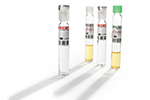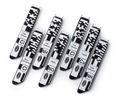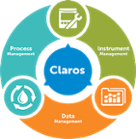Industrial effluent sent to a Municipal wastewater treatment works is subject to wholesale charging. This level of charge is based on the Mogden Formula below which considers many factors. The resultant bill Industrial companies receive is calculated and charged.
Calculating Your Bill
Using the below drop-down menu you can calculate your effluent bill based on the variables used in the Mogden formula. Simply follow the guide and input data where needed.
Copies of the wholesale charges depending on your water company can be found here: Anglian Water, Northumbrian Water , Scottish Water, Severn Trent Water , Southern Water , SWW , Thames Water , United Utilities, Welsh Water , Wessex Water , Yorkshire Water .
Disclaimer:
The above calculator is based on Hach programming of the standard Mogden Formula, and your actual effluent bill may differ from the values obtained in this calculator.
The Mogden Formula explained
R + [(V + Bv) or M] + B (Ot/Os) + S(St/Ss)
- R = reception and conveyance charge [p/m 3]
- V = primary treatment (volumetric) charge [p/m 3]
- Bv = additional volume charge if there is biological treatment [p/m 3]
- M= treatment and disposal charge where effluent is discharged to sea outfall [p/m 3]
- B= biological oxidation of settled sewage charge [p/kg]
- Ot= Chemical oxygen demand (COD) of effluent after one hour quiescent settlement at pH 7
- Os= Chemical oxygen demand (COD) of crude sewage one hour quiescent settlement
- S= treatment and disposal of primary sewage sludge charge [p/kg]
- St= total suspended solids of effluent at pH 7 [mg/litre]
- SS= total suspended solids of crude sewage [mg/litre]
The formula is fully explained above but the parts which are most relevant to industrial companies are the parts you have control over. These are Chemical oxygen demand (COD) represented by (Ot) in the formula, volume (V) and suspended solids (SS)(St).
Continuous measurements are often better than spot samples
In order to be able to control these elements you firstly need to accurately measure them. A refrigerated auto sampler can take these samples and your laboratory or wastewater technician can test these. This will ensure you have representative data and are not simply billed on the water companies spot samples.
COD can be measured in the lab using a spectrophotometer, heating block and suitable COD test kits. This will only give you a COD reading at the exact time you take the sample. If your effluent does not vary this may be sufficient to ensure you are being accurately billed. A more representative way is continuous monitoring via an analyser which will give you COD readings at pre-set intervals (maximum one every 7 minutes). This allows you to trend data and observe any peaks where action can be taken to minimise the COD being discharged. Not only will this reduce your resultant charge but it will enable you to take action to ensure compliance with your permit.
Suspended solids (SS)(St) can be measured by taking a spot sample and analysing in the lab or again more accurately using an online suspended solids probe. The probe measures suspended solids continuously and the data can be sent to your SCADA system or simply logged and trended using the software embedded in the controller.
Volume is an area where control can affect the effluent charge. However, by reducing the volume you can often increase the strength which would result in higher COD and SS values therefore a balance is often best. With volume being an important part of the formula and charges based on volume, no longer is dilution the best way forward. Dilution may allow you to meet you permit conditions but could result in a higher Mogden charge due to the increased volume.
Treatment control systems: High return on investment
A more direct approach to reduce your effluent bill is to implement treatment at your facility. That can be in the form of biological treatment, chemical treatment, filtration, or solids removal via systems such as DAF plants (Dissolved Air Flotation). Monitoring the effectiveness of these treatment systems is crucial to ensure optimal treatment. Hach also have solutions for monitoring and control of all these systems via online instrumentation or real time process control ( RTC). The cost of treatment control systems can be expensive and the savings from these on your effluent bill can often offset the costs with return on your investments often seen within 2 years. An example of a system Hach installed to optimise ferric dosing resulted in a reduction of the customers chemical usage by 25%. The return on investment seen was 11 months.
Basic laboratory monitoring can equip you to demonstrate to your water company that your effluent bill is correct. Without this visibility you are at the mercy of the spot checks your billing company take.






